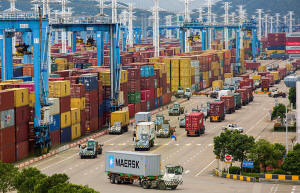China's exports rise solidly, but slower imports temper outlook
 Send a link to a friend
Send a link to a friend
 [June 07, 2024] By
Joe Cash [June 07, 2024] By
Joe Cash
BEIJING (Reuters) - China's exports grew more quickly and for a second
month in May, suggesting factory owners are managing to find buyers
overseas and providing some relief to the economy as it battles to mount
a durable recovery.
The jury is still out, however, on whether the export sales are
sustainable while a protracted property crisis has led to persistent
weakness in domestic demand - a factor highlighted again in last month's
imports figures.
"Headline export numbers are surprisingly good, and that confirms the
underlying trend, volumes are running very high," said Frederic Neumann,
chief Asia economist at HSBC.
“China is currently so competitive, that even trade restrictions
wouldn’t really slow the export juggernaut that’s underway.”
However, "if U.S. demand buckles, then the global trade cycle is quickly
going to fizzle," Neumann said, adding that a sustainable longer term
growth strategy for China requires its domestic engine to fire up.
Outbound shipments from the world's second-largest economy grew 7.6%
year-on-year in value in May, customs data showed on Friday.
But imports increased at a slower 1.8% pace, from a 8.4% jump in the
previous month, highlighting the fragility of domestic consumption.

The export figure beat a forecast 6.0% increase in a Reuters poll of
economists and a 1.5% rise seen in April, though growth was likely also
aided by a lower base of comparison, after rising interest rates and
inflation in the U.S. and Europe squeezed external demand in the
previous year.
Over recent months, a flurry of data has shown different parts of the
$18.6 trillion economy recovering at varying speeds, heightening
uncertainty about the outlook.
While first quarter growth blew past forecasts and strong March export
and output data suggested improving global demand might aid officials'
efforts to get the economy back on an even keel, more recent indicators
reflecting soft domestic consumption have eroded much of that earlier
optimism.
DEPRESSED DOMESTIC DEMAND
Indeed, separate data for May on commodities imports also released on
Friday highlighted a mixed picture of demand conditions at home, with
purchases of crude oil and soybeans down year-on-year, while copper and
iron ore saw a solid uptick.
A protracted property sector crisis remains the biggest drag on China's
economy, with low investor and consumer confidence hurting domestic
consumption and undermining business activity.
However, Friday's trade data should give authorities some breathing
space as they continue their efforts to foster a broad-based economic
recovery.

[to top of second column] |

Lines of trucks are seen at a container terminal of Ningbo Zhoushan
port in Zhejiang province, China, August 15, 2021. Picture taken
August 15, 2021. cnsphoto via REUTERS/file photo

Analysts expect China to roll-out more policy support measures in
the short term, while a government pledge to boost fiscal stimulus
is seen helping shore up domestic demand.
The International Monetary Fund last month upgraded its China growth
forecast for 2024 in line with Beijing's growth target of "around"
5%, but warned of risks to the economy from the property sector
troubles.
China's stocks slipped as the better export numbers were eclipsed by
a report that U.S. lawmakers pushed to ban Chinese battery firms
with ties to Ford and Volkswagen from exporting to the U.S.
HI-TECH BOOST
Friday's shipments data possibly also suggests a global cyclical
upturn in the electronics sector is helping China's sales of
components and finished manufactured goods.
Integrated circuits exports from the Asian giant increased 28.4%
year-on-year in value in May, according to Reuters calculations, in
line with robust chip shipments from neighbouring South Korea last
month, a leading indicator of China's trade performance in
technology sectors.
Beijing has come under growing criticism from the West that Chinese
industrial overcapacity in technologically advanced and green
sectors is flooding markets in the European Union and the United
States, an assertion China has refuted and it has accused Washington
and the EU of engaging in trade protectionism.
China's trade surplus grew to $82.62 billion last month, compared
with a forecast of $73 billion and $72.35 in April, which the U.S.
has repeatedly highlighted in the past as evidence of one-side trade
favoring the Chinese economy.

Last month, the Biden administration unveiled steep tariff increases
on $18 billion of exports, including a quadrupling of tariffs on
Chinese new energy vehicles.
The China trade data shows vehicles exports, including chassis,
increased 16.6% year-on-year by value last month.
"We expect exports to stay strong in the coming months, supported by
a weaker real effective exchange rate. Foreign tariffs are unlikely
to immediately threaten exports," said Zichun Huang, China economist
at Capital Economics.
"If anything, they may boost exports at the margins as firms speed
up shipments to front-run the duties."
(Reporting by Joe Cash; Editing by Shri Navaratnam)
[© 2024 Thomson Reuters. All rights
reserved.]
This material may not be published,
broadcast, rewritten or redistributed.
Thompson Reuters is solely responsible for this content. |